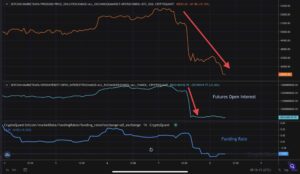
This is not only a bad time for the crypto markets, but also for crypto derivatives such as Ethereum futures.
There is indeed a strong loss of interest being observed.
Ethereum: the decline in volumes on crypto futures
Among the traditional stock exchanges, the one where the most crypto futures on Ethereum are traded is the CME in Chicago.
The Chicago Mercantile Exchange (CME) is indeed the Chicago stock exchange, and it is by far the largest options and futures market in the world.
Although there are crypto exchanges with higher trading volumes of ETH futures, the CME should be taken as a reference point for trading crypto futures on traditional markets.
Starting from April, the trading volumes of futures on Ethereum at the CME have been decreasing.
Although this is not at all to be considered good news, there are however two other elements to add that make it less bad than it might appear at a superficial examination.
First of all, although the trading volumes in July and August were significantly lower than those in March, they remain higher than those in January and February.
Furthermore, at the end of July, other derivatives on Ethereum were launched on the US exchanges, namely the spot ETFs, and these should have taken away some trading volumes from the futures.
Therefore, the decrease in the trading volume of Ethereum futures on the CME is not particularly serious.
Crypto news: the closure of ETFs on Ethereum futures
This second piece of news may also seem negative at a superficial approach, while instead it does not appear so much upon a slightly more in-depth investigation.
It has been officially declared that VanEck will close the ETF on Ethereum futures.
Before spot ETH ETFs could be launched on the US markets, other ETFs were launched that did not have ETH as collateral but futures contracts on the price of ETH.
Now that the spot ETH ETFs have been launched, those based on futures make little sense to exist.
So not only is there no reason to be surprised if VanEck closes its Ethereum futures ETF, but it is actually to be expected that many other issuers will do the same, in case the new ETFs gain significant interest in traditional financial markets.
The overall volumes during the cycles of the crypto market
Analyzing instead the overall volumes of Ethereum futures trading on all exchanges, the picture that emerges is decidedly less negative.
In October of last year, before the last bullrun began, the overall volumes were around 10 billion dollars weekly.
With the start of the bullrun, they rose above 20 billion, with a peak of almost 50 billion dollars weekly around mid-November.
After a slight decline in December 2023 and January 2024, in February they rose again, reaching around 50 billion weekly in March.
Since then, in fact, they have fallen, so much so that after mid-May they returned below 20 billion, but continuing to remain much higher than those just before the start of the bullrun.
In fact, in July they even went back above 40 billion, even if only for one week, and the greatest decline was recorded only in August, when many operators are on vacation.
The volumes at the beginning of September have returned above 20 billion, therefore perfectly in line with those at the end of October 2023 or May 2024.
In other words, there has not been an overall net decline in trading volumes on Ethereum futures, if all exchanges are taken into consideration, while a decline is recorded instead particularly on traditional exchanges such as the CME.
The spot ETF
It is therefore not a real problem related to the crypto market, but a shift of volumes on traditional exchanges from futures to new ETFs.
The fact is that on one hand there has been a significant loss of AUM by the ETFs on ETH spot since they landed on the US exchanges, but not a loss of volumes.
The sharp drop in AUM (-568 million dollars) is due to the liquidations of ETHE, Grayscale’s ATF which was previously a non-traded fund, and over the years had accumulated too many ETH.
Indeed, taking as a reference even just ETHE alone, its trading volumes have increased since it transformed into an ETF.
In March, it had never significantly exceeded 300 million dollars in daily trading volume, while in July it surpassed 500 million several times.
From the point of view of trading volumes, the new spot ETH ETFs must be considered a success in every respect, even if not as sensational as those on BTC. However, from the point of view of AUM, for now, they cannot be considered a success if taken as a whole, although it must be said that only ETHE lost (-2.6 billion dollars), while the other ETFs together recorded total inflows of more than 2 billion dollars.
Unfortunately, the outflows from Grayscale’s Ethereum ETF are still ongoing, but as soon as they stop, as happened in February for those on Bitcoin, there could be a trend reversal.














